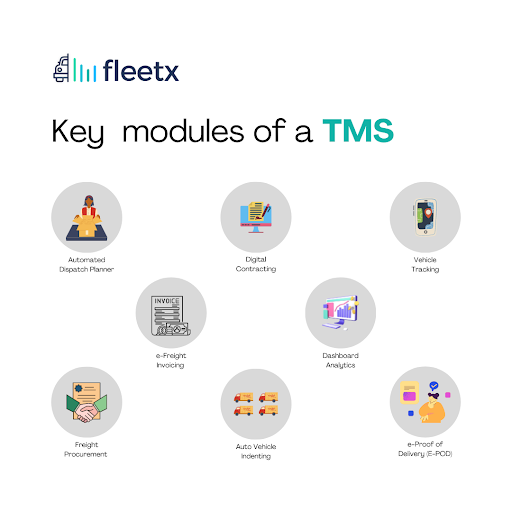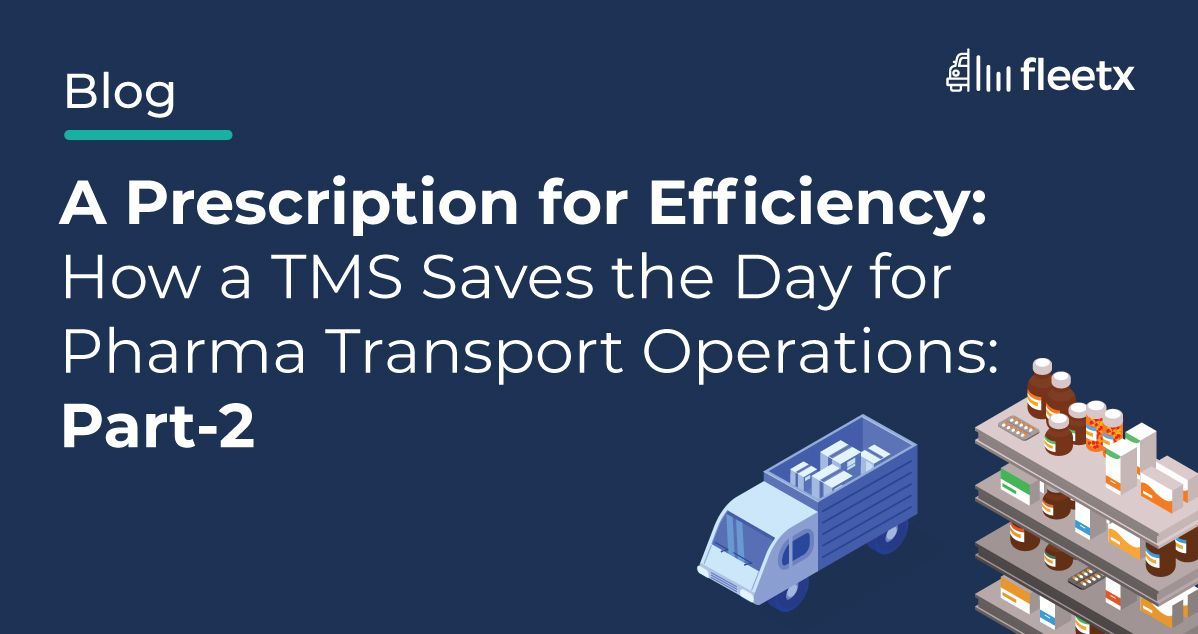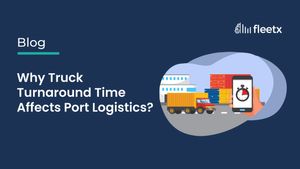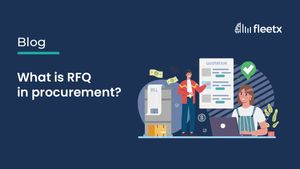
Continuing our discussion from our previous article, which focused on the most crucial module of a Transportation Management System (TMS) - the automated dispatch planner - we will now explore the other modules that comprise a TMS and examine their potential benefits for the pharmaceutical industry.
Key modules of a TMS?

- Automated Dispatch Planning
- Freight Procurement
- Auto Vehicle Indenting
- Digital Contracting
- Tracking of the vehicle/shipment
- E-POD and E-LR
- E-Freight Invoicing
- Dashboard Analytics
Benefits of the Freight Procurement in a TMS
Among other challenges a pharma company may face other obstacles related to supply and logistics management, expense control, and stringent rules. By adopting a data-centric approach to contract administration, businesses can get assistance in managing all phases of the contract procedure throughout the shipping cycle. This approach would facilitate the handling of complex contracts in the pharma industry with strict compliances and detailed monitoring of line items, along with the management of delivery schedules, to enhance transportation operations seamlessly. Furthermore, pharma companies can effortlessly construct and supervise agreements with numerous suppliers, including complex procurement and indent logic.
Benefits of Auto Vehicle Indenting or Auto Requisition
A lot has already been discussed about the automated dispatch planning module of a TMS. The next important module is related to sending indents to transporters on behalf of your pharma company. To put it simply, an indent is a request sent to partner transporters stating the requirements for trucks to transport goods to their respective delivery locations at a given time and date. It also includes other details such as the number and type of trucks needed and the order of delivery. Before TMS, all of this information was provided manually to the transporter, based on manual assessment from the manufacturer. However, with a TMS equipped with an automatic dispatch planner, this information is provided to transporters in the most efficient manner to maximise the utilisation of resources.
The indenting process itself is quite repetitive and manual, as someone has to physically connect and follow-up with the transporter to discuss the terms of the contract, among other things. Furthermore, someone from the logistics team also needs to follow-up with the driver, retrieve information on the trucks, and verify compliance with several other requirements. Manually managing all these tasks related to indenting leaves ample room for errors and can be expensive for larger operations.
However, the Auto Vehicle Indenting module of a TMS can automate all these processes, leaving no room for error. Additionally, notifications regarding indent updates are automatically shared electronically via email, SMS, WhatsApp, as well as pop notifications on the TMS mobile and web app. Transporters also respond to the indent electronically.
The most significant benefit of using a TMS is that the manufacturer or shipper can receive all the information related to the quantity, type of trucks, and the expected time of arrival of the trucks. In case of any failure on the transporter's end after accepting the contract, the shipper can take corrective action well in advance and arrange for a substitute vehicle when using a TMS. Corrective action is also possible manually, but it results in a loss of crucial time for shippers, leading to a loss of revenue and higher operating costs.
Benefits of the Contracting Module in a TMS
Companies typically work with multiple transporters (an average of three) on every delivery route they operate. Therefore, it is essential to ensure that the share of business is distributed fairly among partner transporters, and contracts are equitably disbursed. This is achieved through the contracting module, where all charges, such as base rates, incidental charges, and additional charges in the form of penalties and extra charges, are maintained in the digital contract module. This ensures that all contract principles are followed according to the agreement.
Benefits of Tracking shipment in real-time with the vehicle tracking module
Businesses and transporters who manage their logistics and transport operations manually have no supply chain visibility once the cargo is loaded on the trucks and departs from the shipper's warehouse or manufacturing plant. This lack of supply chain visibility has been one of the most pressing issues plaguing Indian businesses and their respective transport operations. However, with a TMS, you have complete visibility of your shipment and the trucks carrying your goods through some form of tracking.
The vehicle tracking module offered by TMS provides pharma companies and their customers with real-time location updates of their shipment using either a GPS tracking system or a SIM-based tracking system. The real-time tracking module of the TMS provides all information in the form of Estimated Time of Arrival (ETA) and alerts all relevant stakeholders, especially the consignee in case of delays or unforeseen accidents or incidents. Accurate ETAs can help the consignees/channel partner prepare for unloading and dispatch appropriately and without delays.
This feature is especially beneficial for pharma goods due to their sensitive nature. The real-time vehicle tracking module of the TMS is a boon for the pharma industry as it helps to ensure that the products are delivered on time and in the right condition. This can help pharma companies maintain their product's quality, integrity and safety, which is of utmost importance in the industry.
Benefits of the E-Proof of Delivery (E-POD) or E- Lorry Receipt (LR) module
The next module pertains to the Lorry Receipt (LR) or Bilty, which is generated during the time of dispatch. Four copies of the LR are created, out of which one copy is retained by the shipper, i.e. the pharma company. Of the remaining three copies, one is kept by the consignee while the remaining two are given to the driver and are eventually handed over to the transporter. One of the two copies provided to the shipper or the pharma company contains all the information related to the date, time, and condition of the delivery, signed by the consignee. The transporter will receive payment only when it provides the freight invoice and Proof of Delivery (POD) to the shipper.
A TMS with its electronic Proof of Delivery (e-POD) module simplifies the entire process for all the stakeholders, specially the transporter that had to deal with misplaced or missing LRs. E-POD ensures that there is no loss of LR in transit. Electronically generating LR makes it more convenient to abide by all compliances and SLA adherence. A TMS also makes dispute resolutions much easier and simplifies the penalty application process. Faster trip closure by uploading the E-POD along with damages improves the overall efficiency of the process as well.
Benefits of the Freight Invoicing module in a TMS
The base freight rate for a vehicle is set in the contract, but the shipper must pay for overhead charges like detention fees for container use outside a port or terminal. The transporter may also be penalised for delayed deliveries, vehicle placement issues, cargo theft, and other problems, which will be deducted from their payment by the shipper.
Some common issues for the shipper include paying the additional detention charges while disputes from the transporters can include penalties for delayed deliveries, non-placement or delayed placement of trucks, damaged goods, and cargo theft among others.
Disputes over extra charges and penalties are common between shippers and transporters, but the e-Freight module of a Transportation Management System (TMS) can help resolve them with electronic-Proof of Delivery (e-POD) enabled negotiations. After negotiation and approval, the software generates electronic freight invoices.
Using a TMS-enabled e-Freight Invoicing module can reduce the delivery to invoicing cycle for the transporter by up to 50%, improving cash flow and bringing transparency to the invoicing process. This can also help the transporter get better rates for its services in the long run, benefiting both parties. The module can also prevent duplicate invoicing and provide a multi-level approval mechanism for greater transparency. In the medium-to-long term the transporter can also get better rates for its services, in turn benefitting the shipper with more competitive rates for freight transportation.
Benefits of the All-in-one Dashboard for TMS
The dashboard provides a single screen summary of your entire business operations and can be used for analytics and report generation. You can review a transporter's performance across its KPIs, such as timely deliveries and placements. It also simplifies the contract process allowing shippers to make more informed decisions. A TMS provides transparency across performance metrics, including timely approval of e-PODs, invoicing, and payments, thus, offering transparent information for transporters. A TMS even gamifies information by providing performance-based ratings to both shippers and transporters. Gamification is a more efficient form of analytics that provides maximum information in the least time for better decision making.
The dashboard also enables businesses and transporters to track actual spending against their assigned transport budget, making it easy to identify and address overspending with full transparency.
Final Thoughts
While TMS integrations are still relatively new in India's logistics industry, estimates suggest that shippers can save between 4-7% on freight costs through TMS integration in their transport operations. For specific modules, such as e-Freight Invoicing, the efficiency gains can be even higher, up to 40-50%, with greater potential efficiency as more pharma companies fully adopt TMS in their transport operations.








